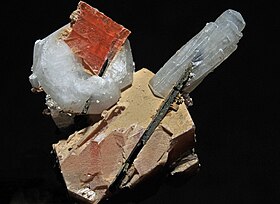
Back Mineraal Afrikaans Mineral ALS Mineral AN खनिज ANP معدن Arabic খনিজ পদাৰ্থ Assamese Mineral AST Минерал AV खनिज AWA Mineral Azerbaijani

In geology and mineralogy, a mineral or mineral species is, broadly speaking, a solid substance with a fairly well-defined chemical composition and a specific crystal structure that occurs naturally in pure form.[1][2]
The geological definition of mineral normally excludes compounds that occur only in living organisms. However, some minerals are often biogenic (such as calcite) or organic compounds in the sense of chemistry (such as mellite). Moreover, living organisms often synthesize inorganic minerals (such as hydroxylapatite) that also occur in rocks.
The concept of mineral is distinct from rock, which is any bulk solid geologic material that is relatively homogeneous at a large enough scale. A rock may consist of one type of mineral or may be an aggregate of two or more different types of minerals, spacially segregated into distinct phases.[3]
Some natural solid substances without a definite crystalline structure, such as opal or obsidian, are more properly called mineraloids.[4] If a chemical compound occurs naturally with different crystal structures, each structure is considered a different mineral species. Thus, for example, quartz and stishovite are two different minerals consisting of the same compound, silicon dioxide.
The International Mineralogical Association (IMA) is the generally recognized standard body for the definition and nomenclature of mineral species. As of March 2024[update], the IMA recognizes 6031 official mineral species.[5]
The chemical composition of a named mineral species may vary somewhat due to the inclusion of small amounts of impurities. Specific varieties of a species sometimes have conventional or official names of their own.[6] For example, amethyst is a purple variety of the mineral species quartz. Some mineral species can have variable proportions of two or more chemical elements that occupy equivalent positions in the mineral's structure; for example, the formula of mackinawite is given as (Fe,Ni)
9S
8, meaning Fe
xNi
9-xS
8, where x is a variable number between 0 and 9. Sometimes a mineral with variable composition is split into separate species, more or less arbitrarily, forming a mineral group; that is the case of the silicates Ca
xMg
yFe
2-x-ySiO
4, the olivine group.
Besides the essential chemical composition and crystal structure, the description of a mineral species usually includes its common physical properties such as habit, hardness, lustre, diaphaneity, colour, streak, tenacity, cleavage, fracture, parting, specific gravity, magnetism, fluorescence, radioactivity, as well as its taste or smell and its reaction to acid.
Minerals are classified by key chemical constituents; the two dominant systems are the Dana classification and the Strunz classification. Silicate minerals comprise approximately 90% of the Earth's crust.[7][8] Other important mineral groups include the native elements, sulfides, oxides, halides, carbonates, sulfates, and phosphates.
- ^ John P. Rafferty, ed. (2011): Minerals; p. 1. In the series Geology: Landforms, Minerals, and Rocks. Rosen Publishing Group. ISBN 978-1-61530-489-9
- ^ Wenk, Hans-Rudolf; Bulakh, Andrei (2004). Minerals: Their Constitution and Origin. Cambridge University Press. p. 10. ISBN 978-0-521-52958-7.
- ^ Stephenson, Tim; Stephenson, Carolyn. "Rocks & Minerals". Creetown Gem Rock Museum. Archived from the original on 18 July 2019. Retrieved 18 July 2019.
- ^ Austin Flint Rogers and Paul Francis Kerr (1942): Optical mineralogy, 2nd ed., p. 374. McGraw-Hill; ISBN 978-1-114-10852-3. Archived 2023-01-17 at the Wayback Machine.
- ^ "The official IMA-CNMNC List of Mineral Names". IMA Commission on New Minerals, Nomenclature and Classification. Archived from the original on 20 July 2023. Retrieved 28 March 2024.
- ^ "Definition of mineral variety". mindat.org. Archived from the original on 2 March 2018. Retrieved 1 March 2018.
- ^ Klein, Cornelis; Hurlbut, Cornelius S. Jr. (1993). Manual of mineralogy: (after James D. Dana) (21st ed.). New York: Wiley. p. 440. ISBN 0-471-57452-X.
- ^ Klein, Cornelis (14 October 2019). "Mineral – Silicates". Encyclopedia Britannica. Archived from the original on 25 October 2017. Retrieved 20 April 2021.
© MMXXIII Rich X Search. We shall prevail. All rights reserved. Rich X Search